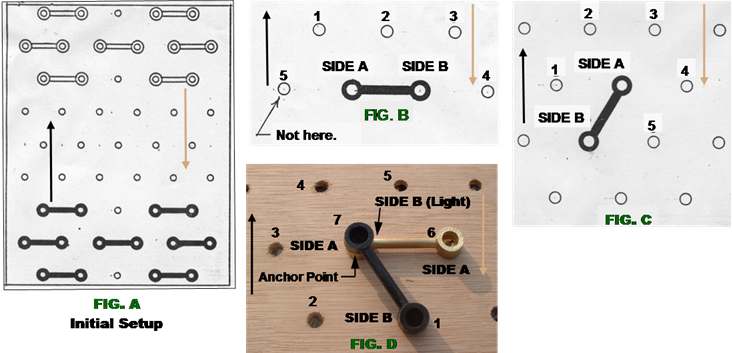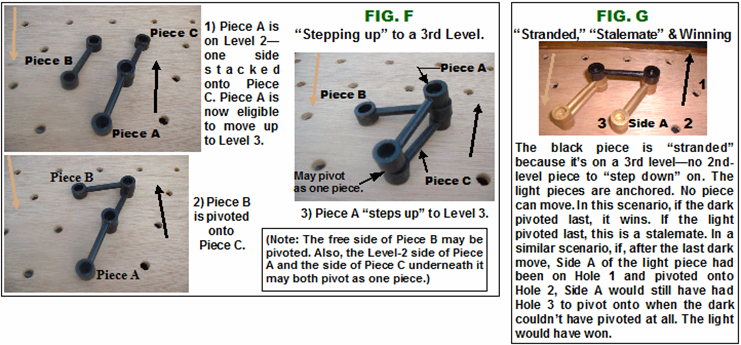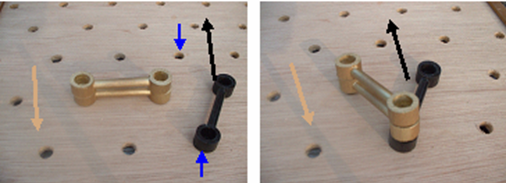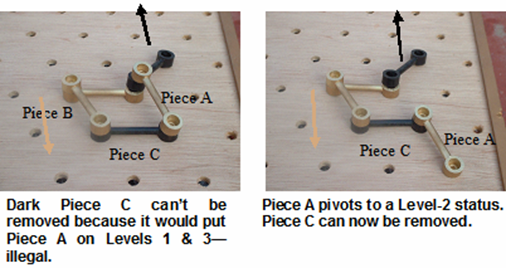

PIVOTATION Board Game Instructions
Keith Anderson, Inventor * P.O. Box 4051 *
Bluefield, WV 24701 * www.pivotation.com * centlist@yahoo.com
Copyright © 2011 by Keith Anderson. All rights reserved.
Movement of Pieces
|
FIG. A shows the initial setup. Dark and light arrows are included to indicate dark and light forward movement; use these as a reference for the pivoting of the pieces regarding these instructions. The black or darkest piece will move first. The pieces move on a pivot, one hole at a time. The pieces may only be pivoted forward and/or to the right but never backward in either direction. So, your opponent will move his/per pieces toward you and/or to your left. In FIG. B, Side A of the piece may be pivoted into holes 2 through 4. Side B may be pivoted into holes 1 and 2. Hole 4 isn’t forward, but it is to the right. Hole 5 is neither forward nor to the right. Another example is in FIG C. Side B may be pivoted into holes 1 through 5. Side A must stay put. These rules of movement also remain in effect regarding stacking, the movement of stacked pieces and anchor-point pieces, and capturing. |

Stacking
|
Stacking gives you the advantage of being protected against being captured, anchored or hindered by pieces on lower levels. It also gives you a greater chance of winning by having more pieces make it to your opponent’s back row (as in Fig. J). The pieces may be stacked onto a single hole or onto both the holes on top of other pieces. You may stack your own pieces or your opponent’s pieces. Level 1 is simply when a piece lays directly on the board itself. No limit is set for the highest stacking level. Stacking levels may be the same (example: 2-2, 3-3) or consecutive (1-2, 2-3). De-stacking (“stepping down”) must also be consecutive (4-3, 3-2, 2-1). When a piece is stacked underneath another piece, the point where it is stacked at is “anchored.” The piece on top of an anchor point may be pivoted, but the stacked piece that is underneath cannot be pivoted by itself at that point. However, the free end of the stacked piece can be pivoted. In Fig. D, the light piece’s Side B is anchored at Hole 7, underneath Side A of the dark piece. Side A of the light piece may be pivoted into Holes 2 & 3 but not into Hole 1 because no piece may be stacked into the hole of any piece that it’s other end is underneath. When one of your pieces has both of its sides anchored underneath one or two other pieces, it can’t be pivoted by itself at all. However, if one of your pieces is stacked directly onto both its holes, and no other piece is anchoring that top piece, you have the option of moving both pieces as one—so long as they are your own pieces; you may not pivot your opponent’s pieces at any time. You may “break” these pieces at any time by simply pivoting the top piece off the bottom one. (See Figs. E, F & H.) (Note: Regarding this, you may pivot as many of your own pieces that are stacked as long as the “Movement of Pieces” rules are followed.) Also, if you have two or more pieces with each having just one of their ends stacked in a common point (anchor point), you may pivot that anchor point into any hole legally accessible to all pieces. (More on this below.)
Capturing If one of your pieces is stacked directly onto both holes of your opponent's piece, or if two of your pieces are stacked directly onto the two separate holes of one of his/her pieces, his/her piece is then captured and removed from the board. Multiple (stacked) pieces can be captured and removed simultaneously. However, no captured piece can be removed at the time that it would put any piece or pieces on illegal levels. In Fig. D, the dark piece captures the light piece when its Side B is pivoted onto Side A of the light piece. (Note: To reduce the risk of “disturbing” the pieces during capturing, it’s best to lift one side of the top pieces at a time and remove the captured piece(s) from that same side before lifting the top pieces from the other side and removing it/them.) |

FIG. E
|
Unanchored ends of 2 light pieces moved as one (left & center photos). At right, top light piece “breaks” from bottom piece. Neither light piece can be moved again until the top black piece is removed from the top. (You may move 2 or more of your own stacked pieces as one.) |
More Examples of Legal Stacked-Piece (Anchor Point) Moves


|
General Rule: Any anchor point may be pivoted into any hole no matter how many pieces are stacked onto said anchor point so long as: 1) the pivot movement is legal to all pieces involved. *2) all pieces within the pivoted anchor point remain together during the pivot movement—see below. 3) your opponent’s piece(s) is/are not pivoted along with your pieces when you pivot your pieces. |
*Illegal Stacked-Piece Move

|
Photo 5: Even though Hole 1 is forward, pivoting the anchor
point into Hole 1 (Photo 6) is illegal because the pieces must be separated
(Photo 7) during the pivot movement. Regarding Photo 5, the only piece that may
be pivoted into Hole 1 is the side of the piece that is on Level 2. |

FIG.
H
Stacked light pieces pivoted as one

|
Extra Note: Pieces, whether stacked or not, cannot “block” the pivoting of other pieces into legal holes. For example, the end of the black piece (indicated by blue arrow) can be pivoted clockwise over the two stacked lighter pieces and into the hole (indicated by the other blue arrow), or it can be pivoted counterclockwise into said hole if desired. Also, as stated earlier, you may simultaneously pivot as many of your own stacked pieces as you can regarding the “Movement of Pieces” rules. Thus, if more light pieces were stacked onto the shown two light pieces, they all could have been stacked onto the black piece (right photo). Also, the top pieces (Levels 2-up) could have “broken off” (like Fig. E) and been pivoted onto the black piece, *with the Level-1 and/or -2 piece(s) left unmoved if desired. (*The Level-3 light piece would have to be pivoted to avoid illegal levels. Example: “Breaking” and pivoting a Level-4 light piece onto the black piece would make that a 4-2 “step down”—illegal.) |
FIG.
I
Levels and Legal Capturing

FIG. J

Object of the Game
(Fig. J shows a possible dark win.)
|
The main object of Pivotation is to maneuver one, or more if necessary, of your pieces completely onto the back row of your opponent uncontested. Your piece that reaches your opponent’s back row is termed “finished.” However, it still can be moved to the right (as far as possible), stacked, capture, and/or be captured.
The finished piece can be stacked onto another piece that is already on the back
row. It can also be stacked on. You have the advantage over your opponent if the
quantity of his/her finished pieces, whether stacked or single, numbers less
than yours. IMPORTANT
NOTE: DO
NOT place
excessive tensile (pulling-force) strain on the game pieces! Use only enough force necessary to pivot them onto other holes/pieces. (The
pieces are not built to take unnecessary pulling force.) Also,
when pivoting the pieces, it’s best to place one finger on the rotating end of
the piece (the end remaining stationary) and to use the other hand to pivot the
other (revolving) end onto its new location, removing your finger from the
stationary end only when the revolved end is firmly in place. (This will help
prevent the stationery end from coming out of its hole.) When pivoting an anchor point (Instructions, Page 2), place a finger and thumb onto the stationery ends and move the anchor point with the other hand. |
![]()